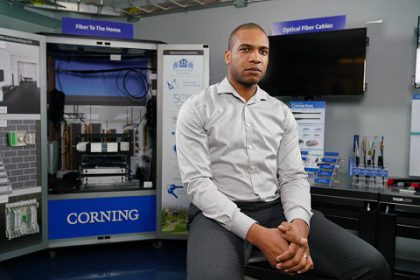
Consider the humble tire. sitting outside on a frosty winter day, it’s hard as a stone, yet when spinning under a drag racer, a tire becomes warmly pliable. For everyday materials, from glass to rubber to plastic, these fundamental changes in behaviour are determined by the glass transition temperature (Tg).
Based on news published at Princeton , for engineers trying to come up with novel materials such as temperature-resistant plastics or flexible glass, the transition temperature is critical. Yet it isn’t well-understood, especially at the level of matter’s molecular building blocks — the nanoscale, near billionths of a meter in size. In this diminutive realm, engineers need to control the transition temperature with unprecedented accuracy to create advanced materials with game-changing properties.
The work was the focus of Dane Christie’s time as a graduate student in chemical and biological engineering at Princeton. Now a materials scientist at Corning Inc., Christie spearheaded the development of a tool probing the transition temperate at the nanoscale level as his doctoral thesis. Richard Register, the Eugene Higgins Professor of Chemical and Biological Engineering, and Rodney Priestley, associate professor of chemical and biological engineering, co-advised Christie during his project. The Princeton professors are co-authors with Christie on two studies describing the tool and its early findings, published in ACS Central Science in February 2018 and Physical Review Letters in December 2018.
The new tool measures transition temperatures in substances composed of two kinds of plastics, or polymers. The two polymers do not mix evenly together, instead forming regions rich in one polymer or the other. The transition temperatures in these regions often don’t match with the normal temperatures for the parent polymers, posing problems in the design, manufacture and deployment of nanoscale materials.
Because the two polymers resist mixing, the concentration of each component polymer often varies substantially over tiny areas. Therefore, to understand varying transition temperatures throughout a polymer mix, scientists need to precisely measure concentrations at multiple points over small scales.
For more information please read: “Source”
About Tg
The glass–liquid transition, or glass transition, is the gradual and reversible transition in amorphous materials (or in amorphous regions within semicrystalline materials), from a hard and relatively brittle “glassy” state into a viscous or rubbery state as the temperature is increased.[1] An amorphous solid that exhibits a glass transition is called a glass. The reverse transition, achieved by supercooling a viscous liquid into the glass state, is called vitrification.
The glass-transition temperature Tg of a material characterizes the range of temperatures over which this glass transition occurs. It is always lower than the melting temperature, Tm, of the crystalline state of the material, if one exists.
Hard plastics like polystyrene and poly(methyl methacrylate) are used well below their glass transition temperatures, i.e., when they are in their glassy state. Their Tg values are well above room temperature, both at around 100 °C (212 °F). Rubber elastomers like polyisoprene and polyisobutylene are used above their Tg, that is, in the rubbery state, where they are soft and flexible.[2]
- ISO 11357-2: Plastics – Differential scanning calorimetry – Part 2: Determination of glass transition temperature (1999).
- ^ “The Glass Transition”. Polymer Science Learning Center.
Read More from the: SOURCE













